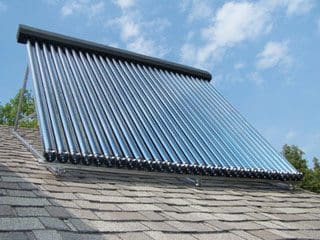
Solar energy (solar radiation) is collected by the solar collector’s absorber plates. Selective coatings are often applied to the absorber plates to improve the overall collection efficiency.
A thermal fluid absorbs the energy collected. There are several types of solar collectors to heat liquids. Selection of a solar collector type will depend on the temperature of the application being considered and the intended season of use (or climate).
The most common solar collector types are: unglazed liquid flatplate collectors; glazed liquid flat-plate collectors; and evacuated tube solar collectors.
Unglazed liquid flat-plate collectors
Unglazed liquid flat-plate collectors, as depicted in Figure 8, are usually made of a black polymer. They do not normally have a selective coating and do not include a frame and insulation at the back; they are usually simply laid on a roof or on a wooden support. These low-cost collectors are good at capturing the energy from the sun, but thermal losses to the environment increase rapidly with water temperature particularly in windy locations.
As a result, unglazed collectors are commonly used for applications requiring energy delivery at low temperatures (pool heating, make-up water in fish farms, process heating applications, etc.); in colder climates they are typically only operated in the summer season due to the high thermal losses of the collector.

Glazed liquid flat-plate collectors

In glazed liquid flat-plate collectors, as depicted in Figure 9, a flat-plate absorber (which often has a selective coating) is fixed in a frame between a single or double layer of glass and an insulation panel at the back.
Much of the sunlight (solar energy) is prevented from escaping due to the glazing (the “greenhouse effect”).
These collectors are commonly used in moderate temperature applications (e.g. domestic hot water, space heating, year-round indoor pools and process heating applications).
Evacuated tube solar collectors
Evacuated tube solar collectors, as depicted in Figure 10, have an absorber with a selective coating enclosed in a sealed glass vacuum tube.
They are good at capturing the energy from the sun; their thermal losses to the environment are extremely low. Systems presently on the market use a sealed heat-pipe on each tube to extract heat from the absorber (a liquid is vaporised while in contact with the heated absorber, heat is recovered at the top of the tube while the vapour condenses, and condensate returns by gravity to the absorber).

Evacuated collectors are good for applications requiring energy delivery at moderate to high temperatures (domestic hot water, space heating and process heating applications typically at 60°C to 80°C depending on outside temperature), particularly in cold climates.
SOURCE: Clean Energy Project Analysis – RETScreen Engineering & Cases Textbook








I am kailash kathat
Hi Can some one tell me any calculator of Solar Tubewell I need to Take out water from 400 Feet Depth so what type of DC/AC Motor and how much Solar Panels are required for 2.5 Inches Pipe Hoping for ur Positive response Thank’s
Info at kaikashkathat@yahoo.com
Hi Can some one tell me any calculator of Solar Tubewell I need to Take out water from 100 Feet Depth so what type of DC Motor and how much Solar Panels are required for 2.0 Inches Pipe Hoping for ur Positive response Thanx
hello mr. edvard, i will continuing my study in master degree on august, and i will take renewable energy topic, especially solar energy, i live in tropical country, Indonesia. I am beginner in solar energy, i need more detail explanation, from basic concept for sure. do you have any recommendation book?, thank you.
Nice Information about solar Collectors…… Keep Continuing your good works…. EEP Rocks
Thanks Sat!
Some really fantastic work on behalf of the owner of this internet site, absolutely great subject material.
Thank you very much for kind words! Great efforts have been made to EEP’s content.
BR